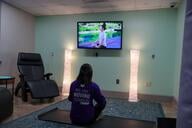You have /5 articles left.
Sign up for a free account or log in.

iStock.com/arthobbit
In the past few weeks, a number of colleges and universities, particularly highly selective institutions, have announced that they will invite back to campus a fraction of their undergraduates this fall in an effort to lower campus density.
Princeton and Stanford Universities, for example, have both announced they will allow only half of their undergraduates to return to campus in the fall, with both splitting the student body down class lines and allowing first-year students in the fall and seniors in the spring.
Harvard, Georgetown and Emory Universities are inviting back only first-year students and a few others who need to be on campus, including students with clinical requirements or an unsafe home situation.
Yale University said all undergraduates but sophomores would be allowed back this fall, while that exclusion will shift to first-year students in the spring.
Is It Safer?
The effort to de-densify campus could have a public health benefit if the extra space is used to spread people out across classrooms and residence halls, said Craig Roberts, an epidemiologist emeritus at the University of Wisconsin, Madison, and a member of the American College Health Association's COVID-19 task force.
"If the reduction is being done solely for budget reasons, however," he said, such as to "keep class sizes the same but have fewer classes with fewer instructors, then I don't think it's going to make much difference."
Research shows household density and crowding, rather than overall population size, is what matters in terms of transmission risk, said Roberts.
"If people congregate, they will spread virus. If they remain apart, they won't," he said via email. "Of course even if a school is less dense in the classroom, if those students still crowd into bars (or wherever) then I think the strategy is less likely to work."
Who Can Do It?
The partial residential return gives institutions a middle ground to bring back the number of students administrators believe they can keep safe and manage.
Highly selective universities might be more likely to take this partial approach because they can afford to, said Kevin McClure, a professor of higher education at the University of North Carolina, Wilmington.
"Some of those institutions that are moving forward with this plan can do so because they're probably much less reliant on income from housing and dining services and feel that they can make this decision without risking losing students who may decide to go elsewhere," he said.
Smaller, more accessible private institutions are more likely to push for a "normal" semester and have students living on campus because they are more likely to rely on that income to operate, said McClure.
Selective universities also have the resources to be flexible and pivot to this option this late in the summer, said Erin Hennessy, vice president of TVP Communications, who works on communications with higher education institutions and formerly worked for the American Council on Education.
"There are some less well-resourced, smaller, tuition-dependent institutions for whom it is 'They all come back or we are sunk,'" she said.
Many colleges have prioritized first-year students and seniors in the return to campus, decisions Hennessy said make sense strategically.
"These institutions have been talking to [incoming] students for months about what the experience is like at their institution and trying to help them imagine it," she said, "and it's really difficult to look at the fall semester and say 'We're going to have to ask you to imagine what it's like to be part of our community for a couple more months.'"
And seniors, Hennessy said, are more likely to need hands-on or technical courses for academic progress.
"These students are about to graduate and become alumni," she said. "You want to give them the best senior year experience that you can under COVID terms so that you have students who are leaving the institution and feeling positively about their experience and are more willing to support the institution moving forward."
Managing the expectations and emotions of students and parents can also be a delicate balance.
"It's tough to say to the students who are coming back, 'We're going to give you the best possible experience,' but also say to the ones who aren't coming back 'You're not missing that much,'" Hennessy said. She encouraged institutions to make decisions early and share with students and parents how they are making them.
"You're going to see more [announcements like this] in the coming weeks," she said. "You'll start to see more institutions say, 'It can't be everybody.'"








